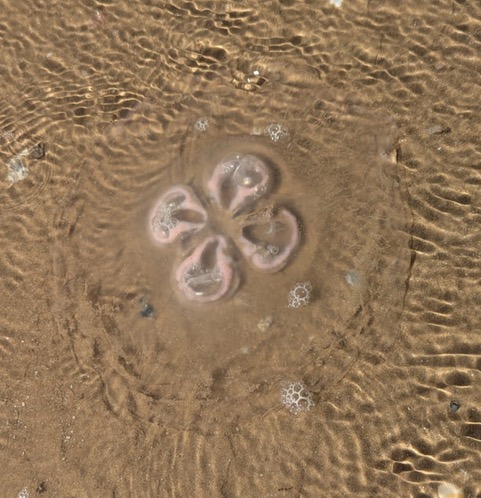With damp, flowery patterns agleam in the sunshine, hundreds of translucent moon jellyfish decorated the sands at Isla Blanca Park one late September afternoon, delighting, but slightly discomfiting my grandchildren, fretful they might be stung. So, rather than swim, my granddaughter and I played “baby crocodiles” in the shallowest of pools formed by the low tide, lest we be unpleasantly surprised.
They needn’t have worried, though. They knew the creatures’ bells, or backs, carried no sting, having recently enjoyed petting pulsating jellyfish, under an attendant’s supervision, at the Texas State Aquarium. But we didn’t know that even this jellyfish’s nematocytes, or stinging cells, under its bell, deliver only a very mild sting. I habitually carry a container of vinegar for stings, just in case.
The common moon jellyfish (Aurelia aurita) swims in coastal waters throughout the world, especially near North America and Europe. Hurricane Francine likely prompted September’s bloom, or bunching of jellyfish, and succeeding storms have caused more strandings. Isla Blanca’s seashore teemed with jellyfish in October —some right-side up, others upside down, arms flopping and organs palpable, and a few, folded like tacos. Alas, our shores are their graveyards, where jellyfish and others in the phylum cnidaria—including Portuguese men-of-war and by-the-wind sailors—dry out in the sun.
The moon jellyfish has a moonlike bell with what looks like a four-leaf clover, its gonads, visible underneath, a male’s being white, a female’s, pink. Short, mucous-covered, nematocyst-filled tentacles frill its underside. These, with the help of hairlike cilia, create a kind of feeding net to trap its prey—plankton and various larvae and eggs. Its four oral arms move prey into its mouth, a multipurpose hole.
This jellyfish has three layers: the epidermis, or outer layer, which protects organs, gastrodermis, an inner layer, and the mesoglea, or middle jelly, sandwiched between them. One can see its stomach, consisting of four lobes, through its bell. Having no gills—as well as no respiratory, circulatory or excretory system—it derives oxygen from the water via thin membranes covering its body.
One might assume that this jellyfish, being brainless, has no senses. However, notches between scallops in its bell bear eight rhopalia, or club-shaped sensory organs, each containing two rudimentary eyes, which react to light. This jellyfish can also determine its position, like whether it is right side up or upside down.
An adult jellyfish is a medusa, named for the mythological Greek monster whose snaky hair turned onlookers into stone. In invertebrate fashion, the medusa first undergoes several stages of development, and, fascinatingly, it sometimes skips a step or returns to a previous one. (With the world of invertebrates so alien to us, I often wonder why we don’t concentrate more on them, rather than enthuse about life on faraway planets).
A male jellyfish releases sperm, which swim into the orifice of a nearby female. Then, in grooves on her oral arms, she produces larvae, called planula, which look like tiny, cilia-ringed discs. A planula swims till it attaches itself to a rock, another object, or the sea floor. Then it lengthens itself into tubed tentacles and builds a digestive tract down its middle, including a mouth, thus becoming a polyp, which may live in this form for as long as 25 years. A medusa lives for only a year or so.
While medusae reproduce sexually, polyps do so asexually, budding into two or more individuals. On the seafloor, one may break off a piece of foot, a fragment that may remain there for years, then, under favorable conditions, sprout into a polyp, like a plant from a seed.
A polyp, often prompted by changes in salinity or ocean temperatures, matures into an ephyra—a name of a Greek water nymph—its final stage before adulthood. In a process called strobilation, the polyp’s tube elongates, and a stack of pancake-like discs erupts where tentacles once were. Baby medusae float away to become adults in a few weeks.
Sea turtles regularly prey upon moon jellyfish, evidenced by the triangle-shaped bites we see on them. Moon jellyfish are about 95% water, but they do make for easy pretty.
Research on moon jellyfish abounds, including studies of how they propel themselves through water, their primitive senses and how they react to microplastics. Moon jellyfish have been launched into space to study weightlessness, and researchers study their statocysts, or cell clumps that give them a sense of directionality, for help with human hearing. Following is a short, informative video by Jace Tunnel at the Harte Research Institute for Gulf of Mexico Studies at A&M Corpus Christi:

